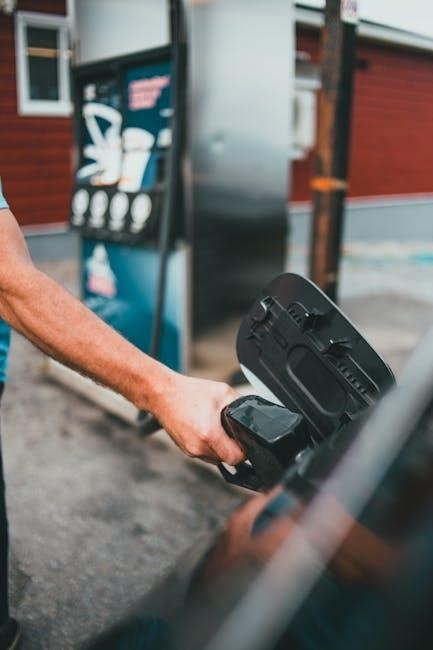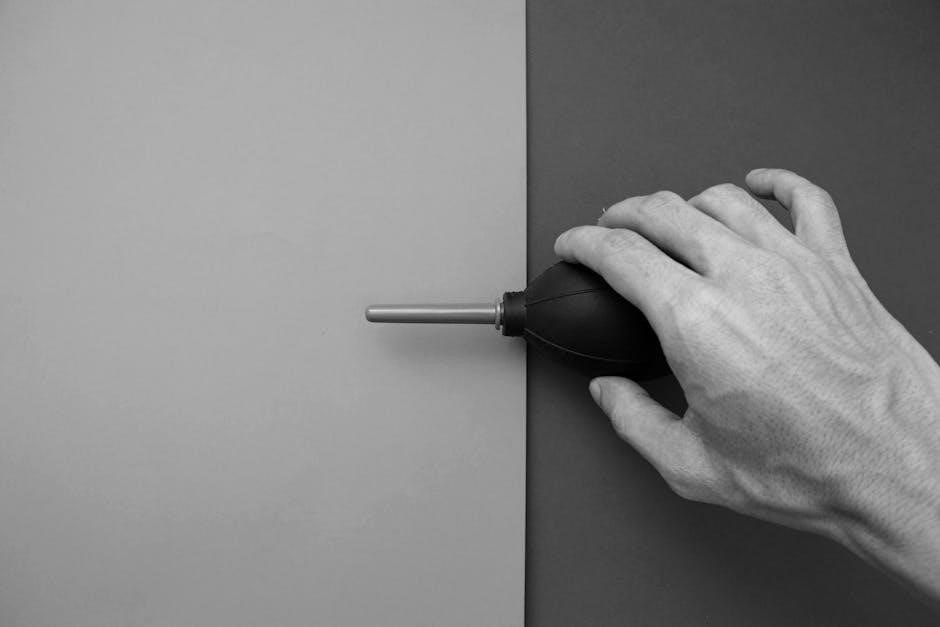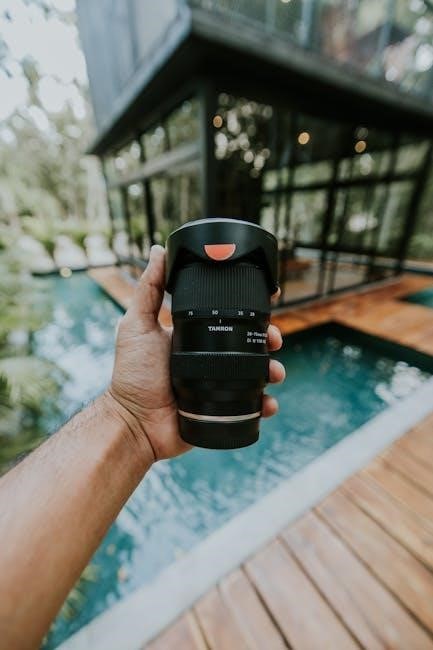Intex Pool Pump Manual: A Comprehensive Guide
Welcome! This guide provides a thorough understanding of your Intex pool pump. Carefully read all instructions before installing and using this product. Keep this manual for future reference. Ensure proper operation and maintenance of your Krystal Clear filter pump by following these instructions.
Intex pool pumps are designed to keep your pool water Krystal Clear and refreshing, offering an effective solution for maintaining water quality. These pumps, suitable for Intex pools up to 6,000 gallons, utilize a 1.25-inch (32mm) diameter hose fitting for easy connectivity. With a water flow rate at the pump of 1,000 gallons per hour (3,785 liters per hour), they ensure efficient filtration.
The strainer grid prevents large objects from entering and potentially damaging the filter pump. Always place the filter pump the length of the hose away from the pool wall. It’s crucial to read, understand, and follow all instructions carefully before installation and use. Intex reserves the right to change specifications and appearance due to continuous product improvement, so updates to the manual may occur.

These pumps can be operated manually or using a timer mode. Safety is paramount; always adhere to the provided precautions and warnings. The power cord plug must be positioned more than 3.5 meters away from the pool walls. Regular maintenance, including cleaning and filter replacement, is essential for optimal performance. This manual will guide you through initial setup, operation, troubleshooting, and provide product specifications and support information.
Understanding Your Intex Pool Pump Model
To effectively use your Intex pool pump, it’s essential to understand the specific model you own. Each Intex pool pump model comes with unique specifications and features tailored to different pool sizes and usage requirements. Identifying your pump model is the first step in ensuring proper setup, operation, and maintenance. The model number is typically found on a label affixed to the pump housing.
Knowing your model number allows you to access the correct product specifications. These specifications include the pump’s flow rate (gallons per hour or liters per hour), voltage requirements, and recommended pool size; The manual will guide you through initial setup, operation, troubleshooting, and provide product specifications and support information. Some models may include additional features, such as timer modes or compatibility with saltwater systems.
Refer to your pump’s specific documentation for detailed information on its components, functionality, and troubleshooting tips. This information is crucial for diagnosing and resolving common issues, such as airlocks or reduced water flow. Always read, understand, and follow all instructions carefully before operating the pump. Intex reserves the right to change specifications and appearance due to continuous product improvement, so updates to the manual may occur.
Initial Setup and Installation
The initial setup of your Intex pool pump is a critical step to ensure optimal performance and longevity. Before you begin, carefully unpack all components and verify that you have all the necessary parts as listed in the product manual. Read all instructions carefully before beginning installation. Choose a location for the pump that is level, stable, and protected from the elements.
Place the filter pump the length of the hose away from the pool wall. Ensure the power cord can reach the electrical power source. The power cord plug must be positioned more than 3.5 meters away from the pool walls.
The strainer grid prevents large objects from damaging the filter pump. For pools with an inflatable top ring, install the strainer, nozzle, and air jet valve. Tighten or reinstall hose clamps to prevent leaks. Make sure the air jet valve is facing up. It is important to follow the pool’s installation instructions carefully. After completing the physical setup, double-check all connections to ensure they are secure. This will prevent leaks and ensure efficient water circulation.

Connecting the Pump to Your Pool
Connecting your Intex pool pump to your pool involves a few key steps to ensure proper water circulation and filtration. First, ensure that the pool is filled to the appropriate level, typically indicated by a waterline mark on the pool liner. Before connecting the hoses, make sure the pump is switched off and unplugged from the power source to prevent any electrical hazards during the process.
Identify the inlet and outlet ports on both the pool and the pump. The inlet port on the pool is where water enters the pump for filtration, while the outlet port is where the filtered water returns to the pool. Attach the appropriate hoses to these ports, ensuring a secure and tight connection. Use hose clamps to reinforce the connections, preventing leaks and maintaining optimal water flow.

Once the hoses are connected, double-check that all connections are secure before turning on the pump. Slowly prime the pump by allowing water to flow into it, removing any air pockets that may be present. This can be done by loosening the air purge valve until water starts to flow out, then tightening it once the air is released. Finally, plug the pump into the power source and turn it on to begin the filtration process.
Operating the Pump: Basic Functions
Operating your Intex pool pump involves understanding its basic functions to maintain clean and clear pool water. The primary function of the pump is to circulate water, drawing it from the pool, filtering it, and then returning it. This process helps remove debris, algae, and other impurities, ensuring a safe and enjoyable swimming environment.
To start the pump, ensure it is properly connected to the pool and a power source. Most Intex pumps have a simple on/off switch. Turning the pump on initiates the filtration cycle. The pump will then draw water through the strainer grid, which prevents large objects from entering and damaging the filter. The water then passes through the filter cartridge, where finer particles are trapped.
Regularly monitor the pump’s operation to ensure it is running smoothly. Check the water flow and listen for any unusual noises that may indicate a problem. The pump’s performance can be affected by factors such as a dirty filter cartridge or air in the system. Cleaning or replacing the filter cartridge as needed is crucial for maintaining optimal performance. Proper operation ensures your pool water remains Krystal Clear throughout the swimming season.
Timer Mode Operation
The timer mode on your Intex pool pump offers convenient, automated operation, allowing you to set specific run times for the pump without manual intervention. This feature is especially useful for maintaining consistent water quality and saving energy. To access the timer mode, refer to your pump’s control panel, where you’ll typically find buttons or settings dedicated to timer functions.
Programming the timer involves selecting the desired number of hours for the pump to run each day. For example, you can set the pump to operate for 2, 4, 6, 8, or 12 hours, depending on your pool’s needs and usage. Once the timer is set, the pump will automatically start and stop at the programmed times each day. This ensures regular water circulation and filtration, keeping your pool water clean and clear.
To operate the sand filter pump manually (without the TIMER mode): Turn on the pump. It is essential to monitor the pump’s performance and adjust the timer settings as needed based on factors such as weather conditions and pool usage. By utilizing the timer mode effectively, you can optimize your pool’s maintenance schedule and enjoy a hassle-free swimming experience.

Maintenance: Cleaning and Filter Replacement
Regular maintenance, including cleaning and filter replacement, is crucial for optimal performance and longevity of your Intex pool pump. A clean filter ensures efficient water circulation and filtration, preventing debris and contaminants from clouding your pool water. The frequency of cleaning and replacement depends on pool usage and environmental factors.
To clean the filter cartridge, first, turn off and unplug the pump. Remove the filter housing and carefully rinse the cartridge with a garden hose. Use a filter cleaner to remove stubborn debris. Inspect the cartridge for damage and replace it if necessary; For cartridge filter pumps, replacing the filter every two weeks is recommended for optimal performance.
For sand filter pumps, backwashing is essential. Backwashing reverses the water flow, flushing out accumulated debris from the sand. Perform backwashing when the pressure gauge indicates higher than normal readings. Additionally, inspect the strainer grid regularly to prevent large objects from damaging the pump. Proper maintenance ensures your pool water remains crystal clear and refreshing throughout the swimming season. Always inspect and maintain your equipment regularly.
Troubleshooting Common Issues
Encountering issues with your Intex pool pump can be frustrating, but many problems can be resolved with simple troubleshooting steps. If the pump isn’t working, first ensure it’s properly plugged into a functioning power outlet. Check the circuit breaker or GFCI to rule out electrical issues. If the pump hums but doesn’t pump water, air may be trapped in the system.
To resolve airlock, try loosening the air purge valve until water flows out, then tighten it. If the pump is leaking, inspect hose connections and tighten clamps. Check for cracks or damage in the pump housing or hoses. If the water is cloudy, the filter may be dirty or clogged. Clean or replace the filter cartridge.
If you have low water flow, ensure that the strainer is clean and free of debris. Also, check for any obstructions in the hoses or skimmer. If these steps don’t resolve the issue, consult the Intex support or a qualified pool technician. Always disconnect the pump from the power source before performing any troubleshooting or maintenance. By following these steps, you can resolve many common issues.
Safety Precautions and Warnings
Prioritize safety when operating your Intex pool pump. Always disconnect the pump from the power source before any maintenance or troubleshooting. Never operate the pump if the power cord is damaged. A damaged cord must be replaced by a qualified technician to avoid electrical hazards. Ensure the pump is properly grounded according to local electrical codes.
Do not bury the power cord; locate it where it cannot be damaged by lawn mowers, hedge trimmers, or other equipment. The pump should be positioned more than 3.5 meters away from the pool walls. Children should be supervised around the pool and pump area. Never allow children to play with or operate the pump.
Be aware of potential suction hazards. Never insert body parts into the pump or skimmer. If using an extension cord, ensure it is rated for outdoor use and is properly grounded; Regularly inspect the pump for any signs of wear or damage. If any issues are detected, discontinue use and contact Intex support. By adhering to these safety precautions, you can minimize the risk of accidents.
Intex Product Specifications and Support
This section details the specifications of your Intex pool pump model. Refer to the model number located on the pump’s housing for precise details. Common specifications include the pump’s flow rate in gallons per hour (GPH) or liters per hour (LPH). Our pumps can handle up to 6,000 gallons. Check the voltage and wattage requirements to ensure compatibility with your power source.
The manual also includes information on compatible filter cartridge types and sizes, essential for maintenance. Due to continuous product improvement, Intex reserves the right to change specifications and appearance, which may result in manual updates. For detailed product specifications, visit the Intex website or contact customer support.
Intex provides comprehensive support for its products. If you encounter any issues, consult the troubleshooting section of this manual. For further assistance, visit the Intex website for FAQs, instructional videos, and contact information. You can also reach our customer service team via phone or email for personalized support. When contacting support, have your pump model number and purchase date ready for efficient assistance.
